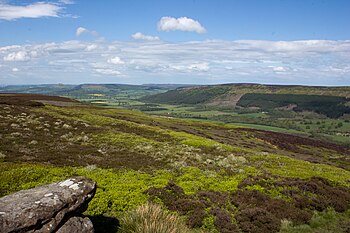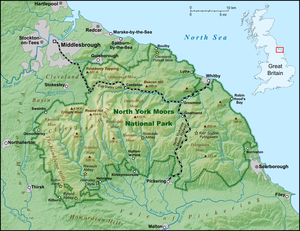Cleveland Hills: Difference between revisions
Created page with "right|thumb|350px|The Cleveland Hills from Urra Moor {{county|Yorkshire}}{{riding|North}} '''The Cleveland Hills''' are a deep ..." |
mNo edit summary |
||
| (2 intermediate revisions by the same user not shown) | |||
| Line 1: | Line 1: | ||
[[File:The_Cleveland Hills from Urra Moor.jpg|right|thumb|350px|The Cleveland Hills from Urra Moor]] | [[File:The_Cleveland Hills from Urra Moor.jpg|right|thumb|350px|The Cleveland Hills from Urra Moor]] | ||
{{county|Yorkshire}}{{riding|North}} | {{county|Yorkshire}}{{riding|North}} | ||
''' | The '''Cleveland Hills''' are a deep range of hills in the north-west of the [[North York Moors]] in the [[North Riding of Yorkshire]], which end dramatically in the cliffs on the riding's North Sea coast. It is the cliffs which give the hills their name, from the Old Norse for 'Cliff land'. | ||
Cleveland has long been a name attached to this part of [[Yorkshire]], in particular along the cliff-bound coast. In the ''Saga of Harald Sigardsson'' it is recorded that King Harald landed in "the place called Cleveland" (and proceeded to burn [[Scarborough]] for resisting him). It provided the name for a mediæval and modern archdeaconry stretching along the coast from the lands beside the [[River Tees]] down to Scarborough. | Cleveland has long been a name attached to this part of [[Yorkshire]], in particular along the cliff-bound coast. In the ''Saga of Harald Sigardsson'' it is recorded that King Harald landed in "the place called Cleveland" (and proceeded to burn [[Scarborough]] for resisting him). It provided the name for a mediæval and modern archdeaconry stretching along the coast from the lands beside the [[River Tees]] down to Scarborough. | ||
| Line 19: | Line 19: | ||
* [[Commondale]] | * [[Commondale]] | ||
* Tripsdale "Bride Stones" | * Tripsdale "Bride Stones" | ||
* [[Thimbleby, | * [[Thimbleby, Yorkshire|Thimbleby]] "Nine Stones" | ||
===Mining and industry=== | ===Mining and industry=== | ||
| Line 101: | Line 101: | ||
{| | {| | ||
|- | |- | ||
| | |valign="top"| | ||
*[[Carlton-in-Cleveland]] | *[[Carlton-in-Cleveland]] | ||
*[[Easby, Hambleton|Easby]] | *[[Easby, Hambleton|Easby]] | ||
| Line 108: | Line 108: | ||
*[[Great Ayton]] | *[[Great Ayton]] | ||
*[[Great Broughton, Yorkshire|Great Broughton]] | *[[Great Broughton, Yorkshire|Great Broughton]] | ||
| | |valign="top"| | ||
*[[Guisborough]] | *[[Guisborough]] | ||
*[[Helmsley]] | *[[Helmsley]] | ||
| Line 114: | Line 114: | ||
*[[Newton under Roseberry]] | *[[Newton under Roseberry]] | ||
*[[Osmotherley, Yorkshire|Osmotherley]] | *[[Osmotherley, Yorkshire|Osmotherley]] | ||
| | |valign="top"| | ||
*[[Skelton-in-Cleveland]] | *[[Skelton-in-Cleveland]] | ||
*Slapewath | *Slapewath | ||
| Line 128: | Line 128: | ||
*Wainstones, Hasty Bank<ref>{{cite web|url=http://www.stone-circles.org.uk/stone/wainstones.htm|title=The Wainstones|accessdate=6 May 2011}}</ref> | *Wainstones, Hasty Bank<ref>{{cite web|url=http://www.stone-circles.org.uk/stone/wainstones.htm|title=The Wainstones|accessdate=6 May 2011}}</ref> | ||
On Bilsdale West Moor in the Cleveland Hills stands the | On Bilsdale West Moor in the Cleveland Hills stands the 1,030-foot-tall Bilsdale transmitting station, providing 40–50 miles coverage of UHF transmissions for digital TV and radio in the north-east's Tyne Tees television region.<ref>{{cite web|url=http://www.thebigtower.com/live/Bilsdale/Index.htm|title=TheBigTower Bilsdale Transmitter|accessdate=10 May 2011}}</ref> The digital switchover at Bilsdale was completed in two stages, on 12 and 26 September 2012, one of the last transmitters in Britain to complete this operation.<ref>{{cite web|url=http://www.digitaluk.co.uk/when_do_i_switch/tyne_tees|title=Digital UK – Tyne Tees region|accessdate=21 August 2012}}</ref> | ||
==Outside links== | ==Outside links== | ||
Latest revision as of 15:37, 13 December 2015

The Cleveland Hills are a deep range of hills in the north-west of the North York Moors in the North Riding of Yorkshire, which end dramatically in the cliffs on the riding's North Sea coast. It is the cliffs which give the hills their name, from the Old Norse for 'Cliff land'.
Cleveland has long been a name attached to this part of Yorkshire, in particular along the cliff-bound coast. In the Saga of Harald Sigardsson it is recorded that King Harald landed in "the place called Cleveland" (and proceeded to burn Scarborough for resisting him). It provided the name for a mediæval and modern archdeaconry stretching along the coast from the lands beside the River Tees down to Scarborough.
The Cleveland Hills lie entirely within the boundaries of the North York Moors National Park. Part of the 110-mile long Cleveland Way National Trail runs along the hills, and it is a part of Wainwright's Coast to Coast Walk.
The hills, which rise abruptly from the flat Tees Valley to the north, include distinctive landmarks such as the cone-shaped peak of Roseberry Topping, near the village of Great Ayton – childhood home of Captain James Cook.[1]
History
Formation
Geological studies of the Cleveland Hills plateau date the rocks back to the Middle Jurassic age, making the range approximately 161–176 million years old,[2] although the North York Moors are formed on rocks from the Lower Jurassic age resulting in shale erosion along the north and west faces of the hills. Roseberry Topping is an outlier which was formed as a result of erosion, separating it from the Cleveland Hills formation, making it a unique natural hill.[3]
Early man
There are a number of tumuli and stone circles[4] scattered throughout the Cleveland Hills and North York Moors, dating back to the Bronze Age, as well as many cairns that are of varied ages, some of which are relatively modern. Hundreds of flint arrowheads have been discovered during excavations in the hills and dated to the Mesolithic and Neolithic periods, indication of an active population in prehistoric times across the region.[5]
Stone circles in the Cleveland Hills
- Commondale
- Tripsdale "Bride Stones"
- Thimbleby "Nine Stones"
Mining and industry
In 1850, ironstone was discovered by John Marley of Bolckow and Vaughan in the Eston Hills, outliers of the Cleveland Hills, leading to mining on a large scale and the rapid growth of nearby Middlesbrough.[6][7] By the 1870s industry would be producing steel in vast amounts, and mining for coal, alum, jet, cement stone concretions, shale and potash from the hills, as well as employing sandstone and limestone quarries to gather raw materials. Many of the mines and quarries are still evident today.
Hill data
The following heights are some of the highest or most notable in the range.
| Name | Grid reference | Height | |
|---|---|---|---|
| Urra Moor (Round Hill) | NZ594015 | 1,490 feet | |
| Cringle Moor | NZ537029 | 1,417 feet | |
| Carlton Bank | NZ519026 | 1,339 feet | |
| Cold Moor | NZ551035 | 1,319 feet | |
| Hasty Bank | NZ565036 | 1,306 feet | |
| Tidy Brown Hill | NZ603052 | 1,299 feet | |
| Bilsdale West Moor | SE553966 | 1,296 feet | |
| Warren Moor | NZ616075 | 1,099 feet | |
| Gisborough Moor | NZ643123 | 1,076 feet | |
| Easby Moor | NZ590101 | 1,063 feet | |
| Park Nab | NZ614084 | 1,063 feet | |
| Roseberry Topping | NZ579126 | 1,050 feet | |
| Live Moor | NZ505013 | 1,033 feet | |
| Highcliff Nab | NZ610138 | 1,017 feet | |
| Codhill Heights | NZ614127 | 971 feet | |
| Eston Nab | NZ561800 | 794 feet | |
Towns and villages in the Cleveland Hills

There are numerous towns and villages on, or in the vicinity of, the Cleveland Hills including the following:
|
Sights around the hills
- Captain Cook Monument, Easby Moor
- Captain Cook Schoolroom Museum, Great Ayton
- Roseberry Topping
- Wainstones, Hasty Bank[8]
On Bilsdale West Moor in the Cleveland Hills stands the 1,030-foot-tall Bilsdale transmitting station, providing 40–50 miles coverage of UHF transmissions for digital TV and radio in the north-east's Tyne Tees television region.[9] The digital switchover at Bilsdale was completed in two stages, on 12 and 26 September 2012, one of the last transmitters in Britain to complete this operation.[10]
Outside links
References
- ↑ "Captain James Cook – History". http://www.captaincook.org.uk/history.php. Retrieved 17 May 2011.
- ↑ "Natural England: 25 North York Moors and Cleveland Hills". http://www.naturalengland.org.uk/publications/nca/north_york_moors_and_cleveland_hills.aspx. Retrieved 12 January 2013.
- ↑ "Geology – Cleveland Hills – North York Moors National Park". http://www.northyorkmoors.org.uk/cleveland-hills/. Retrieved 6 May 2011.
- ↑ "The Prehistoric Sites of Great Britain". http://www.stone-circles.org.uk/stone/index.htm. Retrieved 7 May 2011.
- ↑ "Kirkletham Museum – First People Overview". http://www.redcar-cleveland.gov.uk/kirkleatham/FirstPeopleOverview.pdf. Retrieved 7 May 2011.
- ↑ "Tees Archaeology". http://www.teesarchaeology.com/projects/eston_hills/index.html. Retrieved 6 May 2011.
- ↑ "Middlesbrough and surrounds". http://www.englandsnortheast.co.uk/Middlesbrough.html. Retrieved 6 May 2011.
- ↑ "The Wainstones". http://www.stone-circles.org.uk/stone/wainstones.htm. Retrieved 6 May 2011.
- ↑ "TheBigTower Bilsdale Transmitter". http://www.thebigtower.com/live/Bilsdale/Index.htm. Retrieved 10 May 2011.
- ↑ "Digital UK – Tyne Tees region". http://www.digitaluk.co.uk/when_do_i_switch/tyne_tees. Retrieved 21 August 2012.